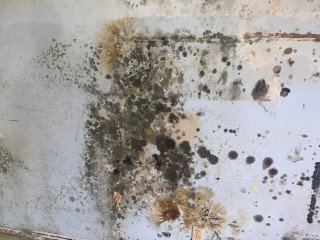Professional Mold Remediation Services
Don't Let Toxic Mold Put Your Family's Health at Risk
Stop mold damage before it spreads. Call now for a free, no-obligation estimate from a local remediation expert.
Free Estimate · Zero Obligation · Available 24/7
Black Mold Mushrooms - Are They Dangerous?
Mold and mushrooms are both types of fungi. So it’s not too surprising when they show up together, especially in damp or neglected parts of a home.
Yes, mushrooms can grow indoors. You might even see them sprouting from your walls, baseboards, or bathroom grout. When that happens, it’s more than just weird — it’s a warning sign of severe moisture problems and potential mold contamination.

Are Black Mold Mushrooms Dangerous?
Let’s start with this.
“Black mold” is a term often used to describe Stachybotrys chartarum, a dark green-black mold that grows on wet drywall, wallpaper, or paper-based materials.
This mold can release mycotoxins, which may contribute to headaches, fatigue, or respiratory irritation when inhaled (CDC).
However, Stachybotrys itself doesn’t typically produce mushrooms. So if you see black mushrooms or fungus caps growing from your floors or walls, another mold or fungus is likely involved. It’s still a red flag, even if it’s not Stachybotrys.
What Are “Black Mold Mushrooms”?
When people refer to black mold mushrooms, they’re usually seeing fungal fruiting bodies — the reproductive stage of certain molds or wood-decaying fungi.
Common culprits include:
- Aspergillus
- Penicillium
- Cladosporium
These species are known to cause allergic reactions and sometimes release mycotoxins, which can aggravate breathing problems or immune issues (NIOSH).
Mushrooms don’t grow unless moisture has been present for a while. That means the environment is wet enough for fungal structures to form — a sign of long-term leaks or poor ventilation.

White Mold Mushrooms Growing Indoors
It’s not just dark mushrooms that raise concern.
White mold mushrooms can also grow on wood, drywall, and insulation. These appear fuzzy or cotton-like at first, then develop tiny white or tan caps.
Even if they look harmless, they can cause:
- Sneezing, coughing, or sore throat
- Itchy eyes or skin irritation
- Musty odors spreading through nearby rooms
Some species release airborne spores that can worsen allergies or asthma in sensitive individuals.
Mold Mushrooms in the Bathroom
Bathrooms provide the perfect environment for mold and mushrooms to grow:
- Constant moisture from showers and sinks
- Warm temperatures
- Poor ventilation
- Damp grout, caulk, or drywall
You might see mushrooms growing behind the toilet, under sinks, or between tiles. In these cases, surface cleaning isn’t enough — the growth likely extends behind the tile or under the floor.
“Fungi that grow indoors due to water damage may include molds that can affect indoor air quality.”
— EPA
If you find mold mushrooms in your bathroom, check for plumbing leaks and make sure your exhaust fan is venting properly.
How to Clean Black Mold Mushrooms
If mold growth is producing mushrooms, it means the colony has matured — so cleaning alone might not solve the problem.
When DIY cleaning may be safe:
- Growth is on non-porous surfaces (tile, glass, metal)
- Area is smaller than 10 square feet
- You’ve fixed the leak or moisture source
Wear protection: gloves, goggles, and a respirator.
Clean using white vinegar, hydrogen peroxide, or EPA-registered antimicrobial cleaners.
Avoid bleach on drywall or wood, since it doesn’t penetrate deeply enough to kill spores.
When to call a professional:
- Mold is growing on drywall, carpet, wood, or insulation
- You notice spores spreading or mushrooms recurring
- The affected area is larger than 10 sq. ft.
- Mold may have spread into the HVAC system
The EPA advises calling a professional for large or hidden mold problems, especially when fungal growth extends behind walls or into ducts.
Can You File an Insurance Claim?
If you discovered mushrooms or mold due to a sudden water leak — for example, a burst pipe or roof failure — it might be covered by your homeowner’s insurance.
However, if the damage resulted from long-term neglect or poor maintenance, coverage is unlikely.
Before removing drywall or flooring, contact your insurance company or a licensed mold inspector for documentation.
What About Pets or Children?
Mold and fungal spores can irritate pets just like humans. Dogs or cats that sniff or lick mushrooms may develop stomach upset or breathing problems.

Keep children and animals away from any indoor mushroom growth until it’s been tested or professionally removed.
Conclusion: Should You Be Concerned?
If mushrooms are growing indoors, you’re not just dealing with surface mold — you’re facing significant moisture damage and possibly hidden structural decay.
Take these steps:
- Identify and fix any leaks immediately
- Avoid disturbing mushrooms or moldy material
- Call a professional if growth extends beyond small patches
- Always wear proper PPE when cleaning
- Focus on drying and dehumidifying the area to prevent regrowth
Mushrooms indoors are never normal. They signal a deeper issue that needs to be addressed quickly to protect both your home and your health.
👉 Schedule a Mold Inspection
👉 Order a Mold Test Kit
Keeping moisture under control is the key to preventing mold — and mushrooms — from taking root in your home.
Explore Related Topics:
Notice an update we should make?
We strive for accuracy. Contact us here if you see incorrect or outdated info on this page.
